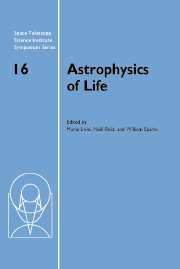 Astrophysics of Life
Astrophysics of Life Book contents
- Frontmatter
- Contents
- Participants
- Preface
- A voyage from dark clouds to the early Earth
- Galactic environment of the Sun and stars: Interstellar and interplanetary material
- Transits
- Planet migration
- Organic synthesis in space
- The vegetation red edge spectroscopic feature as a surface biomarker
- Search for extra-solar planets through gravitational lensing
- The Galactic Habitable Zone
- Cosmology and life
Transits
Published online by Cambridge University Press: 29 August 2009
- Frontmatter
- Contents
- Participants
- Preface
- A voyage from dark clouds to the early Earth
- Galactic environment of the Sun and stars: Interstellar and interplanetary material
- Transits
- Planet migration
- Organic synthesis in space
- The vegetation red edge spectroscopic feature as a surface biomarker
- Search for extra-solar planets through gravitational lensing
- The Galactic Habitable Zone
- Cosmology and life
Summary
Transits of the planets Mercury and especially Venus have been exciting events in the development of astronomy over the past few hundred years. Just two years ago the first transiting extra-solar planet, HD 209458b, was discovered, and subsequent studies during transit have contributed fundamental new knowledge. From the photometric light curve during transit one obtains a basic confirmation that the radial velocity detected object is indeed a planet by allowing precise determination of its mass and radius relative to these stellar quantities. From study of spectroscopic changes during transit it has been possible to probe for individual components of the transiting planets atmosphere. Planet transits are likely to become a primary tool for detection of new planets, especially other Earth-like planets with the Kepler Discovery Mission. Looking ahead, the additional aperture of the James Webb Space Telescope promises to allow the first possibility of studying the atmosphere of extra-solar Earth-analogue planets, perhaps even providing the first evidence of direct relevance to the search for signs of life on other planets.
Transits in history
Transits happen when an obscuring body passes in between us, the observers, and a background luminous source. Historically, both of the planets interior to Earth in the solar system have been observed while transiting the Sun. Mercury transits the Sun from our perspective frequently, Venus transits the Sun from the vantage point of the moving Earth only twice in every 130 years given current orbits.
- Type
- Chapter
- Information
- Astrophysics of LifeProceedings of the Space Telescope Science Institute Symposium, held in Baltimore, Maryland May 6–9, 2002, pp. 35 - 40Publisher: Cambridge University PressPrint publication year: 2005
